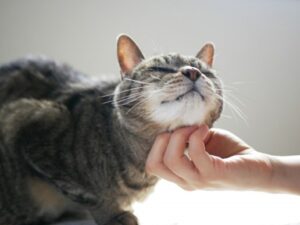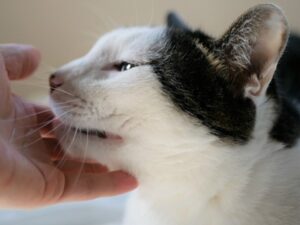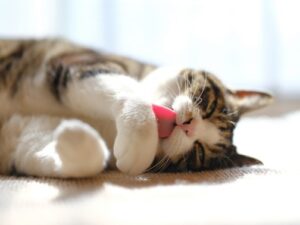
Some cat owners may wonder about the bumps or black powdery substance appearing under their cat's chin. It's actually "cat acne." What are the causes of cat acne, and how can you treat and prevent it? This article will discuss acne that can occur on a cat's chin.
Table of Contents
1. What is Cat Acne
∟1-1. Areas where acne occurs
∟1-2. Symptoms of cat acne
2. Causes of cat acne
∟2-1. Lack of grooming
∟2-2. Issues with food and dishes
∟2-3. Poor health or stress
∟2-4. Acne mites
3. Treatment for cat acne
∟3-1. Keep the affected area clean
∟3-2. Improve food and dishes
∟3-3. Keep the environment clean
∟3-4. Remove the cause of stress
4. Treatment methods and costs at the hospital
Conclusion
1. What is Cat Acne

Cat acne is a type of skin disease that occurs primarily around a cat's chin, where sebum clogs the pores, resulting in the formation of grain-like bumps that appear dark. Medically, it is called "feline acne" or "acne."
While it shares the characteristic of sebum clogging with human acne, which is common in the sebum-secreting teenage years, feline acne can occur regardless of age, gender, or breed.
1-1. Areas where acne occurs
As mentioned earlier, cat acne is commonly found around the chin, but it can also occur around the mouth (lips, corners of the mouth), face, and ears, where sebaceous glands are abundant.
In some cases, symptoms similar to the base of the tail may appear, but this may be a different skin condition called "anal gland infection." Anal gland infections are characterized by excessive secretion of sebum from the anal gland and are often observed in unneutered male cats.
1-2. Symptoms of Cat Acne
The symptoms of cat acne can be classified into mild, moderate, and severe. Here are the symptoms of each:
[1] Mild
Brown or black grain-like substances can be seen around the chin or mouth. There is no itching or pain.
[2] Moderate
Mild inflammation and hair loss may occur in the affected area. Itching develops, and the cat may start scratching the area.
[3] Severe
In severe cases, bacteria or viruses multiply within the skin, leading to secondary infections. The affected area may become red and swollen, and bacterial infection can cause suppuration. Itching and pain intensify, and scratching by the cat can further worsen the condition. If it becomes severe, pathogens can circulate throughout the body, causing fever and loss of appetite.
2. Causes of Cat Acne

The cause of cat acne is sebaceous gland blockage, but why it occurs is not yet fully understood. However, there are several factors believed to cause sebaceous gland blockage. Let's introduce the main ones below.
2-1. Lack of Grooming
Cats groom themselves by licking their bodies to keep clean. However, cats cannot groom the chin and mouth areas where acne is likely to occur. This is because the tongue is not easily reached to these partsensable due to the structure of the tongue.
2-2. Issues with Food and Dishes3>
Cats may develop acne if they come into contact with materials that irritate their chin or mouth. For example, plastic dishes without proper cleaning may harbor bacteria that irritate the skin.
Also, some cats are allergic to certain materials or ingredients in their food. Allergic reactions can cause skin problems such particular reaction is the cause of cat acne. Therefore, it is important to observe whether the symptoms improve after changing the dish or foodensable dish or food. In some cases, it may be necessary to consult a veterinarian and consider a special diet.
2-3. Poor Health or Stress
If a cat is in poor health or under stress, its physical condition may deteriorate, leading to the onset of cat acne. Stress can weaken the immune system, making it difficult for the body to fight against skin problems. If the cat is stressed, it is essential to eliminate the cause of stress as much as possible and provide a comfortable environment.
2-4. Acne Mites
Acne mites are tiny arachnids that can cause acne in cats. These mites are often present on the skin without causing any problems, but if the cat's immune system is weakened, the mites can multiply, leading to acne. In such cases, treatment to improve the cat's immune system may be necessary. Consultation with a veterinarian is recommended.
3. Treatment for Cat Acne
Once cat acne is confirmed, it is important to start treatment as soon as possible. Treatment methods vary depending on the severity of the symptoms. Below are some general treatment methods for cat acne.
3-1. Keep the Affected Area Clean
Clean the affected area with a mild antiseptic solution. This helps remove dirt and bacteria from the acne-affected area. However, do not use human acne medication without a veterinarian's prescription, as it may contain ingredients that are harmful to cats.
3-2. Improve Food and Dishes
If poor diet or dish-related issues are suspected, improve the quality of the cat's diet and consider changing the dish. Use ceramic or stainless steelensable stainless steel dishes instead of plastic, as these materials are less likely to cause irritation. It is also important to clean the dishes regularly to prevent bacteria from accumulating.
3-3. Keep the Environment Clean
Keep the cat's living environment clean. Regularly clean the cat's bedding, toys, and other items. This helps prevent the accumulation of bacteria that can contribute to cat acne. If the cat spends time outdoors, pay attention to its hygiene when it comes back indoors.
3-4. Remove the Cause of Stress
If stress is suspected as the cause of cat acne, identify and eliminate the source of stress as much as possible. Provide a quiet and comfortable space for the cat to rest, and spend quality time playing with and comforting the cat.
4. Treatment Methods and Costs at the Hospital
If the symptoms persist or worsen, it is recommended to consult a veterinarian for a detailed examination. The veterinarian will determine the appropriate treatment based on the severity of the symptoms. The following are some common treatment methods that may be recommended by a veterinarian:
[1] Topical Treatment
A veterinarian may prescribe a topical treatment such as a medicated shampoo or ointment to apply to the affected area.
[2] Antibiotics
If bacterial infection is present, antibiotics may be prescribed to treat the infection.
[3] Steroids
In severe cases, steroids may be prescribed to reduce inflammation and itching.
[4] Allergy Medications
If allergies are suspected, allergy medications may be recommended to alleviate symptoms.
Conclusion
Cat acne is a common skin condition that can affect cats of all ages and breeds. While it may look concerning, it is usually treatable with proper care and attention to the cat's hygiene and environment. If you notice any symptoms of cat acne in your cat, it is advisable to consult a veterinarian for a thorough examination and appropriate treatment. Early intervention can help prevent the condition from worsening and improve the cat's overall well-being.


